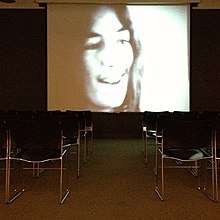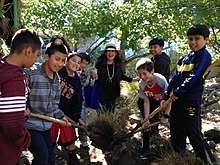Bonnie Sherk
Bonnie Ora Sherk is an American landscape architect, planner, educator, international artist, and founder of The Farm and A Living Library. Sherk is a professional artist who exhibits her work in museums and galleries around the world. Her work has also been published in art books, journals, and magazines.[1] Her work is considered a pioneering contribution to Eco Art.[2]
Bonnie Sherk | |
|---|---|
 Sherk in George Bolling's Newport Beach Revisited (1979) | |
| Born | Massachusetts |
| Education | Rutgers University, San Francisco State University |
Early life
Sherk was born in Massachusetts and grew up in New Jersey.[3]
She graduated Douglass College, Rutgers University in the 1960s. She later enrolled in an MFA program at San Francisco State University.[3]
Career
Sherk moved to San Francisco in the late 1960s.[3]
Sherk is a developer of a systemic, place-based approach to environmental transformation and education which links systems - biological, cultural, technological.[1] Integrated with such innovations, like Green-Powered Digital Gateways, Sherk's approach incorporates interdisciplinary, standards-based, hands-on learning, community ecological planning and design, and state-of-the-art communications and technologies.[1] Sherk's goal is to integrate local resources: human, ecological, economic, historic, technological, and aesthetic - seen through the lens of time - to make relevant ecological transformations, which are integrated with hands-on learning opportunities and community programs.[4]
Participation in group exhibitions (selection, most recent):
- 2014, Vegetation As Political Agent, PAV, Parco Arte Vivente, Turin, Italy[5]
- 2017, Venice Biennale, Viva Arte Viva, May 13 - November 16, 2017.[6][7]
- 2019, Territorios que importan. Arte, Género, Ecologia, CDAN, Centro de Arte y Naturaleza, Huesca, Spain.[8]
Beliefs
In an interview with Peter Cavagnaro, Sherk shares her love and passion for the environment.[4] She believes that the environment is a "beautiful" and "diverse" place and that it is the most practical place for art and to create transformation, because it has the ability to reach communities near and far.[4]
Major works
A Living Library

A Living Library[9] is Sherk's ongoing work[10] that consists of transforming environments -buried urban streams and asphalted public spaces, into thriving art gardens. She has transformed these spaces in order to build education centers for children in communities in San Francisco and New York City.[11][11]
Crossroads Community (The Farm)
Created in 1974, and lasting through 1980, by Sherk, The Farm is a 7 acre eco garden and art space that spreads across traffic meridians and underused spaces under freeway overpasses. It even includes animals. This piece provided internships, educational activities for children, and acted as a public park throughout its duration.
Living In The Forest
Living In The Forest: Demonstrations of Atkin Logic, Balance, Compromise, Devotion, Etc. was an installation created in 1973 for De Saisset Museum in Santa Clara, conceived as a "a metaphor for life in all of its aspects, including birth, death, struggles for survival, compromise, living our daily lives, etc."[3]
Public Lunch
Public Lunch[12][13] was one of Sherk's most well-known performance pieces. The piece consisted of Bonnie eating lunch in cages with various animals, such as lions and tigers, at the San Francisco Zoo. She did this on a Saturday at 2pm in 1971, during normal feeding time and prime spectator watching.[4]
Awards
In 1970, the first SECA Vernal Equinox Special Award, which recognizes conceptual and experimental projects, was presented to Sherk and Howard Levine by the SFMOMA.[14][15]
In 2001, Marion Rockefeller Weber's Arts and Healing Network awarded Sherk the 2001 AHN Award "for being an outstanding educator and for using her creativity to foster environmental healing."[16]
References
- "Bonnie Ora Sherk, Author at Women Eco Artists Dialog". Women Eco Artists Dialog. Retrieved May 21, 2020.
- Weintraub, Linda (2012). To Life! Eco Art in Pursuit of a Sustainable Planet. University of California Press. p. 110. ISBN 978-0520273627.
- Galpin, Pierre-François (December 16, 2013). "Cultivating the Human & Ecological Garden: A Conversation with Bonnie Ora Sherk". Independent Curatorial International. Retrieved May 21, 2020.
- Cavagnaro, Peter. "Q & A :: Bonnie Ora Sherk and the Performance of Being". berkeley.edu. blook. Archived from the original on May 10, 2015. Retrieved November 13, 2014.
- "Vegetation and politics". www.domusweb.it. Retrieved May 23, 2020.
- "Bonnie Ora Sherk and A Living Library Receive International Recognition at Venice Biennale 2017". September 8, 2017.
- "La Biennale di Venezia - Artists". www.labiennale.org. Archived from the original on June 29, 2017. Retrieved February 22, 2017.
- "CDAN | TERRITORIOS QUE IMPORTAN" (in Spanish). Retrieved May 23, 2020.
- "A Living Library – Cultivating the Human and Ecological Garden | ROOSTERGNN". ROOSTERGNN. September 9, 2014. Retrieved July 12, 2018.
- "Focus Areas". WCPUN. October 25, 2011. Retrieved July 17, 2018.
- "Bonnie Ora Sherk". greenmuseum.org. Green Museum. Retrieved November 13, 2013.
- "Writing". Christian L. Frock. Retrieved July 12, 2018.
- Frock, Zimbardo, Christian, Tanya (2015). Public Works Artists' Interventions 1970s - Now. Mills College Art Museum. pp. 116, 117.
- Desmarais, Charles (June 28, 2017). "SECA timeline". San Francisco Chronicle. Retrieved May 21, 2020.
- "SECA Art Award History". SFMOMA. Retrieved May 21, 2020.
- "Bonnie Ora Sherk: 2001 AHN Awardee". Art and Healing Network. Retrieved May 21, 2020.